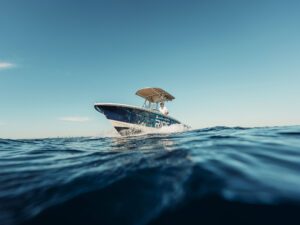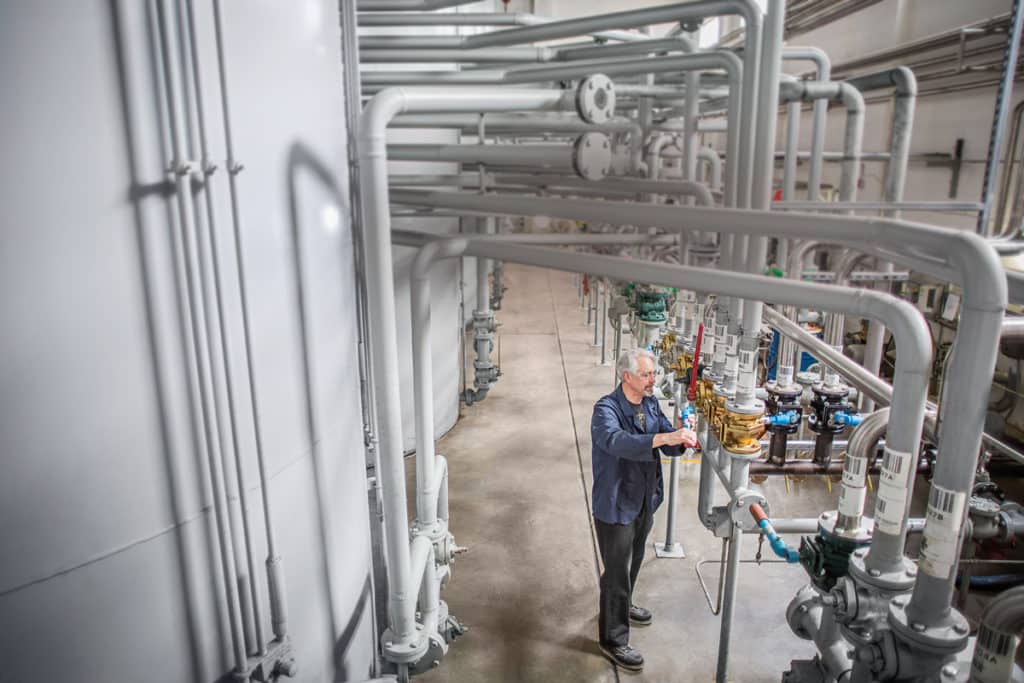
I am not a tribologist.
But I play one for this story. Which is why I’m wearing the lab coat and using a pipette to apply a smidge of oil onto the sample carrier of a Spectroil M spectrometer.
A tribologist is a mechanical engineer who specializes in issues of friction and lubrication, a person you want on your team when cooking up a crock of marine oil. That was my mission when Boating decided to participate in the blending and bottling of a batch of four-stroke engine oil, tracing the process from wellhead to gallon jug.
Marine engine oil is a substance essential to just about any boating mission. It’s also a frequent topic of dockside discussion and queries from our readers, who ask, “What makes marine oil so darn special?”
To answer that question, I hooked up with a real tribologist, Frank Kelley, the guru of lube at Mercury Marine. Conveniently, I embarked on this assignment just as Mercury began to bottle its new four-stroke marine oil. So I not only got to “make” a gallon of the Mercury 25W-40 4-Stroke marine engine oil, but also got to learn a lot about the science behind a modern lubricant.
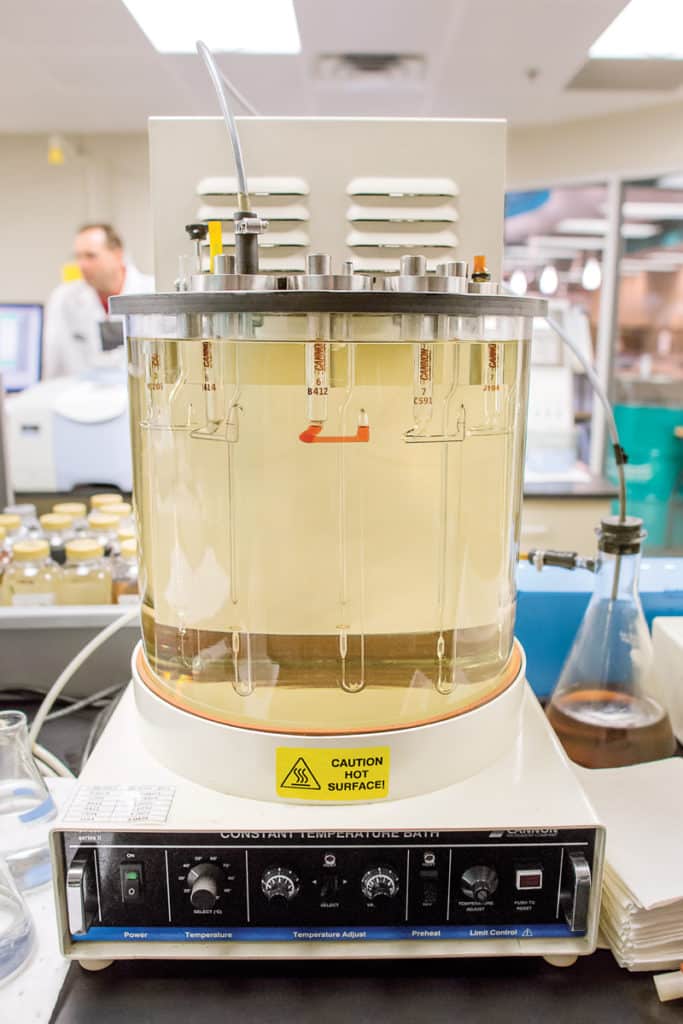
Viscosity is measured by timing the flow of an oil sample through the glass tubing inside this 40 degree Centigrade (104 F) constant-temperature bath. Michael Schoenecker
No original equipment manufacturers (OEMs) of marine engines are in the business of manufacturing their own oil. That’s handled by a specialized lubricant formulator, in this case a business located in Minnesota.
A trip to the west Texas well of origin was not in the budget, so I’ll instead skip the refining process and start my story beside a black 26,000-gallon rail tank car parked behind the oil-blending facility. The rail car hauls base stock, the foundation component of lubricating oil, from refineries in Texas, Mississippi or elsewhere. Base stock is refined to one of four groups. Groups 1 and 2 are called mineral base. Group 3 is more highly refined and called synthetic. Group 4 is polyalphaolefin (PAO), the most refined, and most expensive, base. The Group 1 base is yellow and stinks but is currently more expensive (though traditionally, it’s cheaper). More refined base stock becomes clear, odorless, pure hydrocarbon. According to Mercury, the new Merc 25W-40 is a blend of mineral and synthetic base stocks in a ratio that achieves the desired viscosity and durability.
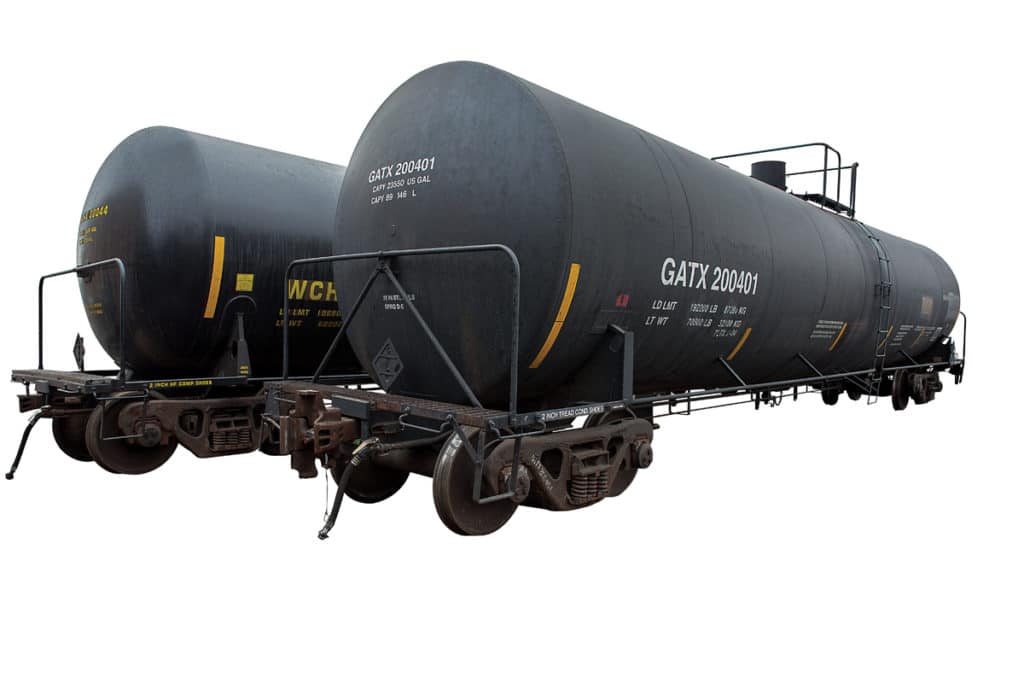
Steam injected into an inner liner of the rail car warms the base stock to a flowable state for unloading during the Minnesota winter. Only about a half-gallon of base stock can be derived from a 42-gallon barrel of crude. The Mercury Marine facility in Fond du Lac, Wisconsin, uses 100,000 gallons of oil each year to factory-fill new engines. Michael Schoenecker
The base stock often used to blend the Mercury oil is pumped from the ground as “west Texas light sweet” crude and is always sourced from the same Texas refinery. The refining process and even the well the crude comes from can affect the properties of the base stock, so it’s constantly tested. The first sample comes right out of the lid on top of the rail car. The Spectroil M uses a crackling plasma energy source to reveal the basic elements of the oil, which are compared to a baseline.
A viscosity bath is used to measure the sample’s viscosity, the fluid’s resistance to flow, which changes with temperature. In the lab, a tribologist measures viscosity at 100 degrees C and at 40 degrees C (212 and 104 F), literally timing how long it takes a specific volume of oil to pass through a very small orifice. Those results are expressed in centistokes (cSt), which are then converted to the SAE scale we see on the bottle — 30-weight, 40-weight, etc. A low-viscosity oil flows when it’s cold to protect the engine on start-up but gets very thin when it gets hot. A higher-viscosity oil protects the engine at operating temperature. A multiviscosity oil, like the Merc 25W-40, behaves like a 25-weight oil when it’s cold but has the protection of a 40-weight oil when it’s hot. One way to achieve this broad viscosity range is to blend viscosity modifier additives with the base oil. The polymeric molecules of viscosity modifier additives get larger as they get hot to increase the oil’s viscosity. However, viscosity modifier molecules are also very prone to shearing — they are literally cleaved by mechanical forces. As they are repeatedly sheared, these modifier molecules become less and less effective, and the oil gets thinner and thinner.

By blending different mineral and synthetic base stocks, the new Mercury oil formula achieves its multiviscosity character without the use of viscosity modifiers, and is thus much less prone to shearing than an oil that uses these additives. That exact formula is a closely held secret, but Kelley says the new oil retains 99 percent of its original viscosity through its service life. Mercury settled on the 25W-40 viscosity range because “that’s where the protection is,” Kelley says.
If its contents pass that first test, a large hose drains the base stock into a series of 20,000-gallon vessels inside the building, part of an indoor tank farm laced with pipes, valves, controls and gauges. There are literally thousands of additive options, with new additives being devised each year. Additives add wear protection, inhibit corrosion, disperse carbon deposits and enhance oxidative stability. Oxidative stability, simply put, means the oil will produce fewer deposits of varnish and sludge. The chance to reformulate with new additives was one reason Mercury chose to engineer a new four-stroke oil. The goal was to develop a single additive package that could be used in Mercury outboards and MerCruiser engines and that would be compatible with legacy products, as well as the latest catalyst-equipped engines, and work well with modern gasoline. Collaborating with its supplier, Mercury blended and tested many new formulas. Each went through engine durability testing and through some special oil “torture” tests, the most critical being a hot-cold-hot-cold cycle in a 60 hp motor that simulates long periods of idle or trolling, to see how the oil handles fuel dilution and water contamination from condensation. Cost is also a concern, but like other OEMs, Mercury says it is willing to make very little profit on its oil in order to offer a superior product. Chemists at the supplier told me that OEM oil invariably tests at the “high end of the scale” because an OEM oil has to back up the engine product. The supplier also stressed that each OEM oil product is quite specific to the needs of that brand’s engines.
“Customer satisfaction always has to come first,” Kelley says of that specificity. “That final formula is backed not only by the brand, but also literally by the signature and reputation of the engineer who approves it.”
Mercury says its new additive package offers 33 percent more wear protection and features a new corrosion inhibitor. The new additives are exclusive to Mercury. There are two versions of the Mercury 25W-40 formula, the standard and the synthetic blend. Both have the same additive package, but the synthetic blend has synthetic base stock and is thus more durable in extreme conditions — wide-open throttle for hours in a big Verado, for example.
Blending the oil is a big chemistry project, done in special blend tanks that circulate the base stocks and additives together with a 360-degree motion. This step requires a lot of precision because some additives need to be blended in stages and some are added only at a certain temperature. The finished blend is transferred to 8,800-gallon fill tanks that feed the bottling line.
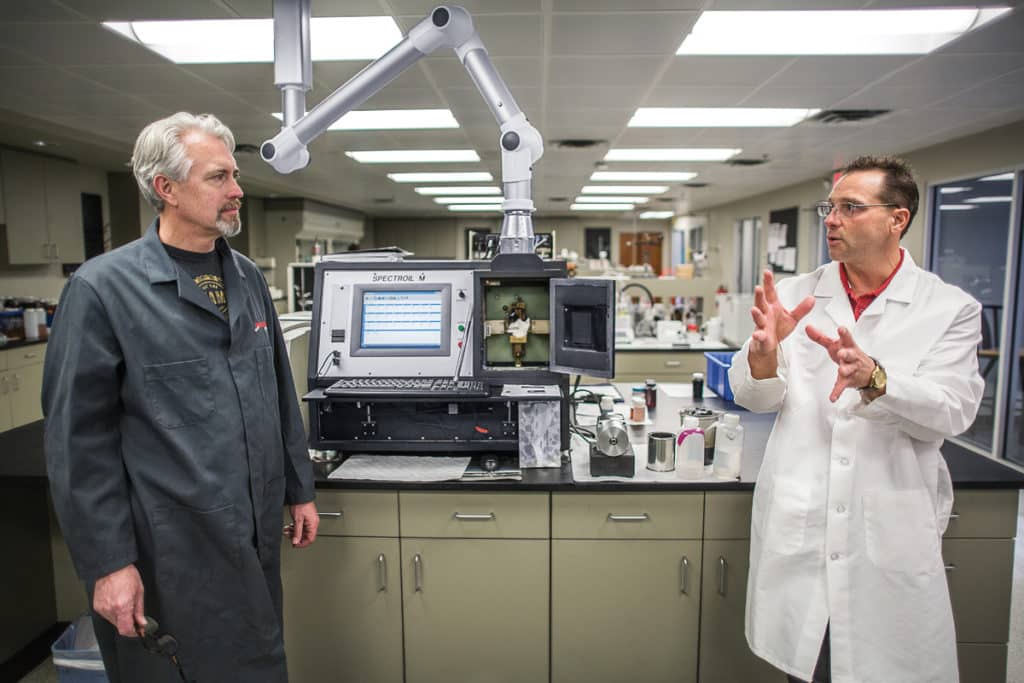
Bottling oil, I’m guessing, is not much different from bottling ketchup. There’s a big tank full of product; a machine squirts the product into bottles and screws on a cap, and the bottle is dropped in a box. During my visit, gallon jugs of Mercury oil were on the line. I helped take empty black jugs from a big box and line them up on a conveyor that carried the jugs to the filler. There, an overhead manifold feeds 12 fill tubes, and a jug comes to rest right under each tube. When the line is started a tech calibrates the filler, gradually filling a jug until it weighs 7.8 pounds on a scale. Then he throws a switch and the fill line takes off. Next, each jug enters a device that screws on a cap that also holds a foil seal. Heat is applied to the cap to weld the seal to the mouth of the jug. The front and back labels are applied simultaneously, along with a date code, and the filled jugs collect on a round stainless-steel table. I’m instructed to inspect the labels for wrinkles before dropping three jugs into each cardboard box. Oil is also packaged in quart bottles and in steel drums.
There’s constant quality control in place. The oil is scrutinized in the lab after the blend process is complete, again before bottling, and finally at the end of the run. One sample bottle or jug from each run is saved as a reference along with samples of the additives used in that blend batch. These are filed away in a warehouse, and if there were ever an issue down the road, oil from the dealer shelves or a failed engine could be compared to the benchmark, using the date code. That same testing can reveal that a failed motor was not filled with Mercury oil, or not even with FC-W marine oil, in which case a warranty claim may be rejected. There is no fooling a tribologist and the Spectroil M.
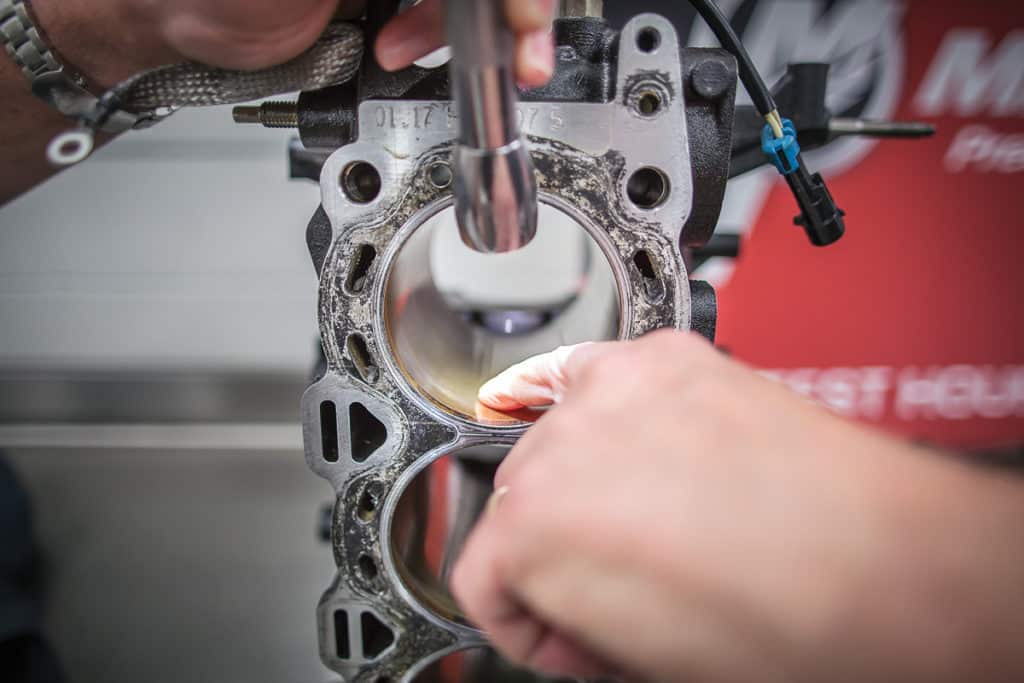
Marine vs. Auto Oil
The basic standard for four-stroke marine engine oil is the FC-W (four-stroke cycle, water-cooled) certification, which was approved by the National Marine Manufacturers Association Oil Certification Committee in 2004. Compared with regular motor oil, FC-W oil features:
More corrosion inhibitors to deal with the marine environment, long periods of inactivity and long periods of operation at low speeds during which the engine is below its ideal operating temperature.
Greater resistance to shearing, the permanent loss of viscosity that occurs when larger oil molecules are cleaved by mechanical forces. Under shear stress, oil can lose its ability to separate moving parts, leading to greater wear or even catastrophic failure in extreme cases. Compared with an auto engine, a marine engine spends much more time at high rpm and under a heavy load, so its oil is more prone to shearing.
An independent lab certifies that marine oil meets the FC-W spec, a test that takes 30 days and costs more than $55,000. The FC-W certification is sort of a “bare minimum” for oil performance. The FC-CW oil sold by engine OEMs significantly exceeds that minimum standard.



